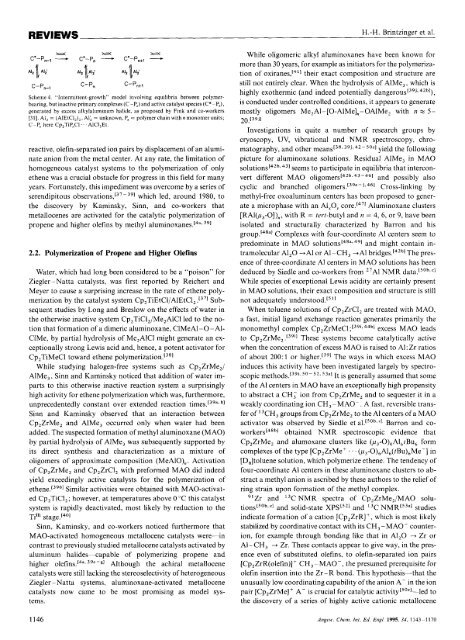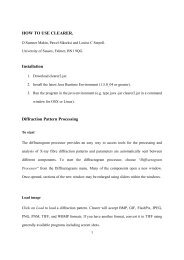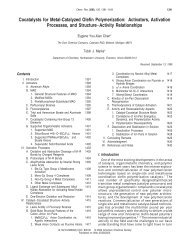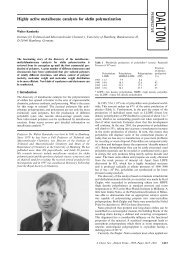Stereospecific Olefin Polymerization with Chiral Metallocene Catalysts
Stereospecific Olefin Polymerization with Chiral Metallocene Catalysts
Stereospecific Olefin Polymerization with Chiral Metallocene Catalysts
You also want an ePaper? Increase the reach of your titles
YUMPU automatically turns print PDFs into web optimized ePapers that Google loves.
REVIEWS<br />
)I: =<br />
C'-P,-, ---) C'-P, + C'-P, -<br />
C-P,-, c-P,<br />
Scheme 4. "Intermittent-growth" model involving equilibria between polymer-<br />
bearing. but inactive primary complexes (C-P,) and active catalyst species (C*-P.),<br />
generated by excess alkykdlumlnum halide, as proposed by Fink and co-workers<br />
[31]. AI2 = (AIEtCl,),, Al; = unknown. P. = polymer chain <strong>with</strong>n monomer units;<br />
C-P,, here Cp,TiP,,CI '. ' AICI,Et.<br />
reactive, olefin-separated ion pairs by displacement of an aluminate<br />
anion from the metal center. At any rate, the limitation of<br />
homogeneous catalyst systems to the polymerization of only<br />
ethene was a crucial obstacle for progress in this field for many<br />
years. Fortunately, this impediment was overcome by a series of<br />
serendipitous observations,[37- 391 which led, around 1980, to<br />
the discovery by Kaminsky, Sinn, and co-workers that<br />
metallocenes are activated for the catalytic polymerization of<br />
propene and higher olefins by methyl alumin~xanes.[~". 391<br />
2.2. <strong>Polymerization</strong> of Propene and Higher <strong>Olefin</strong>s<br />
Water, which had long been considered to be a "poison" for<br />
Ziegler-Natta catalysts, was first reported by Reichert and<br />
Meyer to cause a surprising increase in the rate of ethene polymerization<br />
by the catalyst system Cp,TiEtCl/AIEtCl, .[371 Subsequent<br />
studies by Long and Breslow on the effects of water in<br />
the otherwise inactive system Cp,TiCl,/Me,AICl led to the notion<br />
that formation of a dimeric aluminoxane, ClMeAl-0 - Al-<br />
CIMe, by partial hydrolysis of Me,AICI might generate an exceptionally<br />
strong Lewis acid and, hence, a potent activator for<br />
Cp,TiMeCI toward ethene polymerization.[381<br />
While studying halogen-free systems such as Cp,ZrMe,/<br />
AIMe,, Sinn and Kaminsky noticed that addition of water imparts<br />
to this otherwise inactive reaction system a surprisingly<br />
high activity for ethene polymerization which was, furthermore,<br />
unprecedentedly constant over extended reaction b1<br />
Sinn and Kaminsky observed that an interaction between<br />
Cp,ZrMe, and AIMe, occurred only when water had been<br />
added. The suspected formation of methyl aluminoxane (MAO)<br />
by partial hydrolysis of AIMe, was subsequently supported by<br />
its direct synthesis and characterization as a mixture of<br />
oligomers of approximate composition (MeAIO), . Activation<br />
of Cp,ZrMe, and Cp,ZrCI, <strong>with</strong> preformed MA0 did indeed<br />
yield exceedingly active catalysts for the polymerization of<br />
ethene.[39b1 Similar activities were obtained <strong>with</strong> MAO-activat-<br />
ed Cp,TiCI,; however, at temperatures above 0 "C this catalyst<br />
system is rapidly deactivated, most likely by reduction to the<br />
Ti"' stage.[401<br />
Sinn, Kaminsky, and co-workers noticed furthermore that<br />
MAO-activated homogeneous metallocene catalysts were-in<br />
contrast to previously studied metallocene catalysts activated by<br />
aluminum halides--capable of polymerizing propene and<br />
higher ole fin^.^^". 39c-g3 Although the achiral metallocene<br />
catalysts were still lacking the stereoselectivity of heterogeneous<br />
Ziegler-Natta systems, aluminoxane-activated metallocene<br />
catalysts now came to be most promising as model sys-<br />
tems.<br />
H.-H. Brintzinger et al.<br />
While oligomeric alkyl aluminoxanes have been known for<br />
more than 30 years, for example as initiators for the polymerization<br />
of o~iranes,[~'l their exact composition and structure are<br />
still not entirely clear. When the hydrolysis of AIMe,, which is<br />
highly exothermic (and indeed potentially<br />
42b1 1,<br />
is conducted under controlled conditions, it appears to generate<br />
mostly oligomers Me,AI-[0-AIMe],-OAIMe, <strong>with</strong> n z 5-<br />
20,[39jI<br />
Investigations in quite a number of research groups by<br />
cryoscopy, UV, vibrational and NMR spectroscopy, chromatography,<br />
and other means[38. 39j,42-50c1 yield the following<br />
picture for aluminoxane solutions. Residual AIMe, in MA0<br />
seems to participate in equilibria that interconvert<br />
different MA0 oligomers[42b.43-461 and possibly also<br />
cyclic and branched olig~mers.[~~'-j. 461 Cross-linking by<br />
methyl-free oxoaluminum centers has been proposed to generate<br />
a microphase <strong>with</strong> an A1,0, core.[471 Aluminoxane clusters<br />
[RAI(p,-0]),, <strong>with</strong> R = tevt-butyl and n = 4, 6, or 9, have been<br />
isolated and structurally characterized by Barron and his<br />
Complexes <strong>with</strong> four-coordinate A1 centers seem to<br />
predominate in MA0 sol~tions[~~".~~~ and might contain intramolecular<br />
A1,O +Al or AI-CH, +Al bridge~.[~'~1 The pres-<br />
ence of three-coordinate A1 centers in MA0 solutions has been<br />
deduced by Siedle and co-workers from "A1 NMR data.[sOb.cl<br />
While species of exceptional Lewis acidity are certainly present<br />
in MA0 solutions, their exact composition and structure is still<br />
not adequately understood.["]<br />
When toluene solutions of Cp,ZrCI, are treated <strong>with</strong> MAO,<br />
a fast, initial ligand exchange reaction generates primarily the<br />
monomethyl complex Cp,ZrMeCI 44b1 excess MA0 leads<br />
to Cp,ZrMe, .[39i1 These systems become catalytically active<br />
when the concentration of excess MA0 is raised to A1:Zr ratios<br />
of about 200:l or The ways in which excess MA0<br />
induces this activity have been investigated largely by spectro-<br />
scopic methods,[39i. 50-52, 53al It is ' generally assumed that some<br />
of the Al centers in MA0 have an exceptionally high propensity<br />
to abstract a CH; ion from Cp,ZrMe, and to sequester it in a<br />
weakly coordinating ion CH,-MAO-. A fast, reversible transfer<br />
of 13CH, groups from Cp,ZrMe, to the Al centers of a MA0<br />
activator was observed by Siedle et al.[sOb,cl Barron and coworker~~~~~'<br />
obtained NMR spectroscopic evidence that<br />
Cp,ZrMe, and alumoxane clusters like (p,-O),Al,tBu, form<br />
complexes of the type [Cp,ZrMe+ . . . (p,-O),Al,(tBu),Me-] in<br />
[DJtoluene solution, which polymerize ethene. The tendency of<br />
four-coordinate Al centers in these aluminoxane clusters to abstract<br />
a methyl anion is ascribed by these authors to the relief of<br />
ring strain upon formation of the methyl complex.<br />
91Zr and 13CNMR spectra of Cp,ZrMe,/MAO solution~[~~~.~~<br />
and solid-state XPS[521 and 13C NMR[53"1 studies<br />
indicate formation of a cation [Cp,ZrR]+, which is most likely<br />
stabilized by coordinative contact <strong>with</strong> its CH, -MAO- counterion,<br />
for example through bonding like that in A1,O + Zr or<br />
AI-CH, + Zr. These contacts appear to give way, in the presence<br />
even of substituted olefins, to olefin-separated ion pairs<br />
[Cp,ZrR(olefin)]+ CH, - MAO-, the presumed prerequisite for<br />
olefin insertion into the Zr-R bond. This hypothesis-that the<br />
unusually low coordinating capability of the anion A- in the ion<br />
pair [Cp,ZrMe]' A- is crucial for catalytic activity[sOel-led to<br />
the discovery of a series of highly active cationic metallocene<br />
1146 Angcw. Chem. Inl. Ed. EngI. 1995, 34, 11 43 - 11 70






